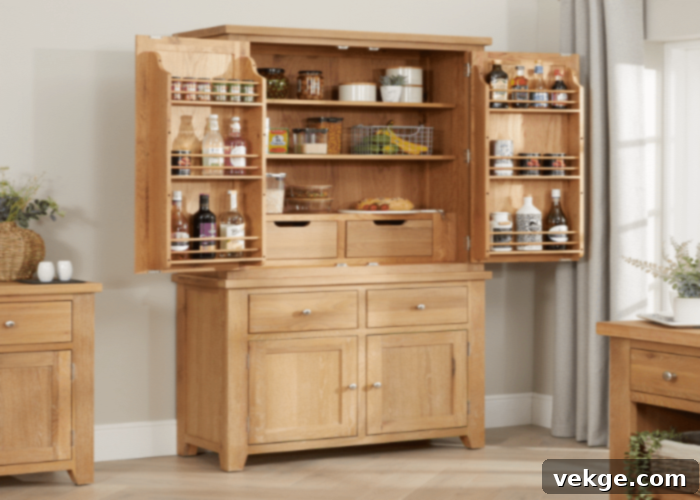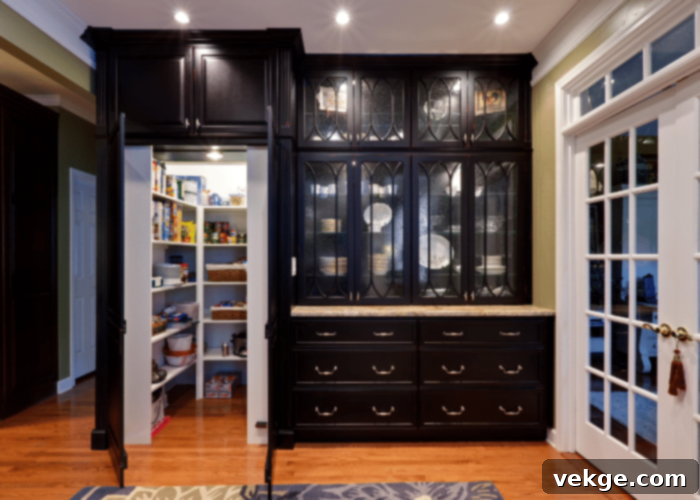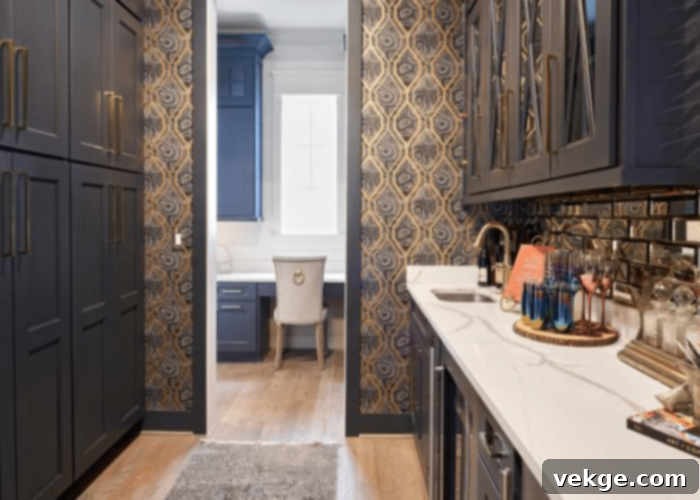Elevate Your Home: The Ultimate Guide to Designing and Choosing Materials for Butler’s Pantry Cabinets
Imagine a space in your home where elegance meets unparalleled functionality, where every serving piece has its designated spot, and entertaining becomes effortless. This dream becomes a reality with the addition of a butler’s pantry cabinet system. Far from being a fleeting trend, these sophisticated pantries are steeped in history, tracing their origins back to the grand estates of the Middle Ages and the colonial homes of early America. Historically, they served as a vital transitional space between the kitchen and dining room, a discreet area for butlers to prepare food for serving, store fine china, silver, and linens, and even manage wines.
Today, the modern butler’s pantry has evolved, embracing contemporary design while retaining its core purpose of organization and display. It offers a multitude of benefits, from decluttering your main kitchen to creating an exquisite showcase for your treasured dinnerware. If you’re contemplating whether to incorporate these elegant rustic cabinets into your home, consider the transformative impact they can have. They not only enhance the aesthetic appeal but also significantly improve the functionality and flow of your living space. Once you’re convinced that a butler’s pantry is the perfect addition to your home, the next exciting step is to explore the vast array of materials available to bring your dream cabinets to life.
Why a Butler’s Pantry is a Must-Have for Modern Homes
In an era where open-concept living often means less wall space for traditional cabinetry, and busy lifestyles demand optimal organization, a butler’s pantry serves as an invaluable solution. Here are compelling reasons why these sophisticated storage areas are gaining immense popularity:
- Superior Organization: A dedicated space allows for meticulous organization of serveware, small appliances, less-frequently used kitchen items, and bulk goods. This frees up valuable cabinet and counter space in your main kitchen, promoting a cleaner, more streamlined environment.
- Enhanced Entertaining: For those who love to host, a butler’s pantry acts as a behind-the-scenes prep area. You can set up drink stations, stage appetizers, or keep dishes warm without cluttering your main kitchen or dining area. It’s an entertainer’s secret weapon, ensuring a smooth and stress-free event.
- Showcase for Valuables: With its often elegant design, a butler’s pantry provides the perfect stage to display cherished china, crystal glassware, or antique serving pieces. Glass-front cabinets or open shelving can transform these items into decorative elements, adding character and personal touch to your home.
- Increased Home Value: A well-designed and functional butler’s pantry is a highly sought-after feature in today’s real estate market. It’s often viewed as a luxury amenity that can significantly increase your home’s appeal and resale value.
- Reduced Kitchen Clutter: By housing various items, a butler’s pantry helps eliminate visual noise in your primary kitchen. This creates a more serene and enjoyable cooking and dining experience, making your everyday life more organized and peaceful.
- Personalized Design Statement: Unlike the main kitchen which often follows current trends, a butler’s pantry offers a unique opportunity to experiment with different styles, materials, and colors, allowing it to become a distinct design statement within your home.
Top Materials for Your Butler’s Pantry Cabinets: A Detailed Guide
Choosing the right material for your butler’s pantry cabinets is crucial, as it impacts both the aesthetics and the longevity of your investment. Each material offers distinct advantages and contributes uniquely to the overall style of your home. Let’s delve into the most popular options:
1. Wood: The Timeless Classic
Wood remains the quintessential choice for butler’s pantry cabinets, and for good reason. Its enduring appeal lies in its timeless effect, the remarkable longevity it provides, and the inherent rustic charm that brings warmth and character to any space. Traditionally, most butler’s pantry cabinets were crafted from fine woods, symbolizing a royal or esteemed home. Different wood species like oak, maple, cherry, walnut, or pine offer varied grain patterns, hardness, and color tones, allowing for extensive customization. From deep, rich stains that evoke a sense of tradition to light, natural finishes that complement a modern farmhouse aesthetic, wood is incredibly versatile. It’s a material that truly stands the test of time, developing a beautiful patina over years of use, and can be refinished to refresh its look. Investing in quality wood cabinets is a one-time expense that pays dividends in both beauty and durability, making it an excellent choice for a space designed for generations.

2. Wood and Glass: Blending Tradition with Modern Sophistication
The combination of wood and glass offers a sophisticated balance, merging the classic warmth of wood with the light, airy feel of glass. This duo is increasingly popular, allowing homeowners to showcase their exquisite dinnerware and decorative items while keeping them protected. Adding glass fronts to upper cabinet doors or shelving introduces a touch of modern elegance and visual interest. Beyond aesthetic appeal, glass plays a practical role by allowing your fancy crockeries and dining sets to remain beautifully on display, becoming part of your home’s decor even when not in use. This approach aligns perfectly with today’s interior design philosophy, which emphasizes proudly exhibiting beautiful belongings. Various types of glass, such as clear, frosted, reeded, or seeded, can be used to achieve different levels of transparency and visual texture, offering endless design possibilities. This blend ensures your butler’s pantry feels both traditional and contemporary, functional yet highly decorative.

3. Marble: Luxurious Integration and Expansive Feel
While often associated with countertops and flooring, marble can make a stunning statement as a material for butler’s pantry cabinets. Our design experts suggest that incorporating marble into your pantry design creates a cohesive and luxurious look, especially if your surrounding kitchen or dining area already features marble elements. This seamless integration ensures the pantry doesn’t feel like a separate entity but rather an organic extension of your home’s sophisticated design. The natural veining and luminous quality of marble instantly elevate the space, adding a touch of timeless grandeur. Moreover, the reflective surface of marble can make the area appear larger and brighter than it actually is, an excellent trick for smaller pantries. To prevent a monochromatic look, you can introduce splashes of color through decorative items like pots, pans, vibrant cutlery, or dishware. For the shelves and cabinet covers, you have the flexibility to combine marble with glass or wood, creating a multi-textured design that is both opulent and practical. Marble’s inherent coolness also makes it a great choice for areas storing certain food items or beverages.

4. Adding Wallpapers: Infusing Personality and Artistry
While not a structural material for the cabinets themselves, wallpaper plays a pivotal role in elevating the mood and style of your butler’s pantry. It’s a fantastic way to introduce personality, texture, and color, transforming the pantry from a purely functional space into a delightful visual experience. The beauty of wallpaper is its versatility and the ease with which it can be changed to refresh the look of the area. From dark and dramatic patterns that create an intimate, moody atmosphere to subtle and sober designs that provide a serene backdrop, the market offers an extensive variety. Our experts often recommend wallpaper for families with diverse tastes, as it allows for a strong design statement that can be updated more easily than permanent fixtures. Adding artistic wallpapers around the pantry area injects freshness and a unique splash of artistry, making the space feel curated and special. You can choose a pattern that perfectly complements your home’s existing décor or opt for a bold contrast to make the pantry a true focal point.

5. Colored Plywood: Affordable Elegance and Modern Charm
For those seeking a more budget-friendly yet stylish option, colored plywood stands out as an excellent choice for butler’s pantry cabinets. Plywood offers a strong resemblance to solid wood, particularly when finished well, but at a fraction of the cost. Its layered construction provides excellent stability and durability, making it a reliable material for cabinet construction. While readily available colored plywood might be less common, the versatility comes in its ability to be painted any color imaginable, allowing for complete customization to match your desired aesthetic. This means you can achieve a rustic effect, a vibrant modern look, or anything in between, without the heavy price tag of solid wood. Plywood is also lighter than solid wood, making installation potentially easier, and when properly sealed and painted, it can withstand the rigors of a busy pantry for extended periods. It’s an ideal solution for achieving a personalized and attractive butler’s pantry without compromising on quality or style.

6. Stainless Steel: Contemporary, Durable, and Hygienic
Stainless steel has seen a surge in popularity for kitchen and pantry cabinetry, and for good reason. Its robust nature makes it exceptionally durable, ideal for a butler’s pantry often used to store heavier items or small appliances. If your goal is to create a sleek, modern, or even an industrial-chic aesthetic, stainless steel is an unparalleled choice. One of its most significant advantages is its longevity; unlike other materials, stainless steel rarely needs replacement, making it a sustainable and cost-effective solution in the long run. It’s also incredibly hygienic and easy to clean, resisting stains, rust, and bacteria – a significant benefit for food preparation and storage areas. While you might find fewer style options compared to wood, its neutral, reflective surface can be surprisingly versatile, pairing well with various colors and textures. To soften its commercial appearance, you can integrate wooden elements, glass inserts, or even attach wallpapers or artistic panels to beautify these functional pieces further, creating a unique and sophisticated space that truly stands out.

Designing Your Dream Butler’s Pantry: Beyond Materials
While selecting the right materials is fundamental, a successful butler’s pantry design involves several other critical considerations that enhance its functionality and aesthetic appeal. Think about the layout and workflow within the space. Will it primarily be for storage, or will it also house small appliances, a sink, or even a wine fridge? Proper lighting, including task lighting under shelves and ambient lighting, is essential for both visibility and creating a welcoming atmosphere. Consider the types of shelving—adjustable shelves offer flexibility, while pull-out drawers can make accessing items easier. Don’t overlook the hardware; knobs and pulls can be the jewelry of your cabinets, subtly reinforcing your chosen style. Backsplashes, whether tile, stone, or even painted wood, can add another layer of design interest and protect walls from splashes. By meticulously planning these details, you can create a butler’s pantry that is not only beautiful but also perfectly tailored to your lifestyle and entertaining needs.
Conclusion: Embrace the Elegance and Efficiency of a Butler’s Pantry
The resurgence of the butler’s pantry cabinet in modern homes reflects a growing appreciation for functional elegance, effective organization, and the desire to create distinctive, luxurious spaces. This shift is driven by an increased awareness of evolving design trends and the practical need for additional, dedicated storage solutions in contemporary living environments where every square foot counts.
If you’re still contemplating the installation of these amazing and highly functional cabinets, we strongly recommend consulting with a professional interior designer or kitchen specialist. An expert can shed more light on the myriad benefits, help you visualize the potential, and guide you through the process of integrating a butler’s pantry seamlessly into your home. They can assess your specific needs, layout possibilities, and budget to ensure the end result exceeds your expectations.
Furthermore, if you find yourself uncertain about which materials will perfectly complement your home’s existing aesthetics, an expert’s guidance can be invaluable. They can help you navigate the options, from the timeless appeal of wood to the modern sophistication of stainless steel, ensuring a cohesive and harmonious design. If you’ve already committed to enhancing your home with a butler’s pantry, consider it an opportunity to completely remodel or optimize your kitchen area, creating a more spacious, organized, and truly luxurious culinary and entertaining hub. A well-designed butler’s pantry isn’t just an addition; it’s an investment in your home’s beauty, functionality, and enduring value.
